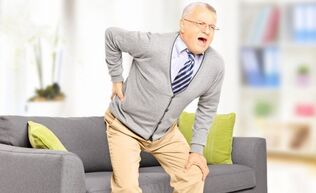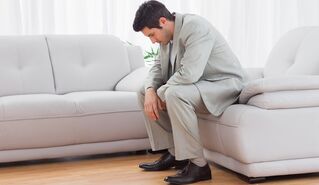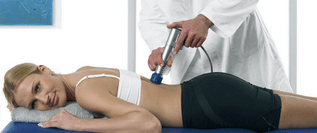
The most common cause of back pain is the development of diseases of the musculoskeletal system such as osteochondrosis. If previously this pathology was found mainly in the elderly and more rarely in middle age, now osteochondrosis is younger, it is often diagnosed in people aged 20-30 years.
According to medical statistics, the disease often affects the lumbar and lumbosacral spine.
Characteristics of this disease
Osteochondrosis is a pathology of the musculoskeletal system that affects its most important component - the spine. It arises due to the fact that dystrophy changes in the intervertebral disc begin to develop.
This disease not only affects the intervertebral disc tissue, negative changes begin to occur in the surrounding tissue, affecting the ligaments and muscles.
The cause of lumbar osteochondrosis is that this part of the spine experiences the greatest physical stress.
With this disease, characteristic changes occur in the nucleus pulposus, which is part of the intervertebral disc. This disk performs an amortization function.
If water exchange in the intervertebral disc is disrupted, it becomes thinner, its fragility increases.
People from the older age group are most susceptible to pathological processes, as metabolic processes in intervertebral disc tissue begin to decline as they reach a certain age.
Under the influence of negative changes, the boundaries of the nucleus pulposus gradually expand, tending to enter the intervertebral space. This usually ends with the transfer of the nucleus to the spinal canal, resulting in compression and pinching of nerve fibers and blood vessels.
Pinching nerves are a cause of pain in osteochondrosis. There may also be a deterioration in the function of internal organs.
With the development of pathology, the strength of pressure on the vertebrae increases. The body strives to compensate for the defects, and the growth of spinal cord tissue is significantly accelerated. As a result, pathological growths - osteophytes - form on the vertebrae. Ultimately, this interferes with impaired spinal function.
With advanced forms of osteochondrosis, patients may experience paralysis of the lower extremities. Due to the delay in getting medical treatment, a person can become disabled.
Causes of lumbar and lumbosacral spine osteochondrosis
Osteochondrosis of the lumbar and lumbosacral spine develops due to improper load distribution on the spine. If this is combined with other negative factors, the development of osteochondrosis is accelerated, it can take a more severe form.

Diseases can be provoked by:
- doing heavy physical work, lifting heavy objects (people with certain professions, as well as athletes involved in weightlifting, are at risk);
- inadequate physical activity, which negatively affects muscle condition and causes deterioration of blood circulation, metabolic processes and decreased amount of nutrients entering tissues;
- overweight patients, which leads to the fact that the spine is constantly exposed to heavy loads;
- problems with incorrect posture and walking style;
- presence of congenital defects or deformities of the spine or overall skeleton;
- flat feet can also cause the development of osteochondrosis, because in patients with foot deformities, the arch cannot fully absorb the load during movement, which causes an increase in load on the intervertebral disc;
- traumatic spine injury;
- genetic disorders of defined bone tissue formation;
- age-related changes;
- infections affecting bone tissue (tuberculosis, osteomyelitis);
- inflammatory processes affecting bones and joints (including rheumatoid arthritis, ankylosing spondylitis);
- vitamin and mineral deficiency;
- exposure to hazardous and toxic substances.
The most common pathological cause is a heavy load on the spine in patients with incorrect posture.
Symptoms of the disease
Manifestations and severity of osteochondrosis symptoms depend on the stage of the disease.

There are 4 stages of the disease:
- The first stage is characterized by the appearance of pain in the lumbar region (lumbago), spasm of the surrounding muscle tissue, and swelling in the affected area. During this period, changes and displacement of the nucleus pulposus of the intervertebral disc begin, causing irritation of the nerve endings.
- In the second stage, the process of destruction of the intervertebral disc fibrous ring begins. The vertebrae become unstable, their movements increase, as a result of which there is a stable tension of the neighboring muscles. Pain is observed along the sciatic nerve. At this stage of the disease, disturbances in the work of internal organs can sometimes begin.
- In the third stage, the rupture of the fibrous ring and the release of the contents of the pulposus nucleus are observed. As a result, a herniated disc is formed. All of these contribute to further deformity of the spine (the development of scoliosis, kifosis or lordosis can be observed). Acute pain becomes permanent, this is caused by radicular syndrome, in which the nerve root is compressed by fragments falling from the fibrous ring.
- The fourth stage is characterized by severe defects in the spine, pathological growths appear in the vertebrae. There may be a significant reduction in pain, but this does not mean an improvement in the patient's condition. On the other hand, one's movement becomes very limited. Typically, patients with stage 4 osteochondrosis require registration of a disability.
One of the main symptoms of this disease is pain in the lumbar region, which can also spread to the tailbone and lower legs. It is divided into 3 types:
- Lumbago- an acute pain attack that begins when making sudden movements or lifting heavy objects.
- Lumbodynia- severe common pain associated with damage to cartilage and intervertebral muscle fibers.
- Lumboishalgia- characterized by a sensation of pain, feeling cold or hot in the lumbar region, as well as in the legs.

A person's psychological state can also cause pain.
In addition to pain, osteochondrosis is characterized by:
- feeling weak in the lower body and legs;
- deterioration of tendon reflex in lower leg;
- tingling, which can be felt from the lower back to the feet;
- curvature of spinal space;
- with lumbosacral osteochondrosis, there is often damage to the function of the pelvic organs (urinary disorders, bowel incontinence, erectile dysfunction);
- skin problems (dryness, flaking, bluish blackness) and sweating changes can also occur in the lower back and buttocks.
If you find any of the symptoms listed, you should see a doctor as soon as possible to begin treatment immediately and prevent serious consequences.
Treatment of lumbar and lumbosacral spine osteochondrosis
Medicine
For patients diagnosed with osteochondrosis, the doctor may prescribe the following types of therapy (including several at once):
- drug treatment;
- physiotherapy procedures;
- medical massage and manual therapy;
- performed a surgical operation.

Let's take a closer look at each of these methods.
Medication is prescribed to relieve pain, fight inflammation and improve the regrowth of diseased tissue. Patients can be assigned:
- analgesics (helps relieve pain);
- muscle relaxation (used to loosen muscle fibers and relieve cramps);
- chondroprotectors (promotes the regrowth of cartilage and bone tissue and protects it from negative influences);
- anti-inflammatory drugs;
- in case of edema, diuretics (diuretics) are prescribed;
- drugs that increase blood circulation;
- vitamin and mineral complex.
In the usual form of osteochondrosis, when conventional analgesics are ineffective, restrictions can be prescribed. What specific medication to use, as well as the scheme and duration of treatment, is determined by the physician, taking into account the severity of the disease and the severity of symptoms.
It is recommended to prescribe physiotherapy with medication to increase the effectiveness of treatment. With osteochondrosis, the following procedure is indicated:
- laser therapy;
- magnetic resonance therapy;
- fonoforesis;
- shock wave therapy.

This treatment helps relieve pain, reduce inflammation, and help repair damaged tissue. The use of laser beams is very effective, this allows you to get a stable deterioration.
When phonophoresis is prescribed, additional topical medications are used (this method allows the medication to penetrate deep under the skin directly into the lesion). To maximize tissue enrichment with oxygen, doctors may also prescribe ozone therapy.
Keep in mind that physiotherapy is contraindicated in certain pathologies. It should not be prescribed to patients with oncological diseases, thyrotoxicosis, diabetes, tuberculosis, infectious diseases.
Massage and manual therapy can be prescribed simultaneously with medications and physiotherapy procedures, which enhance the therapeutic effect.
This method affects the flow of nerve impulses and helps normalize muscle tone.
Surgical intervention is indicated only in the later stages of the disease, when other methods of treatment are useless. Surgery is required if:
- patients experience severe pain that cannot be controlled by medication;
- disc herniation;
- patients are diagnosed with spinal cord compression (this causes impaired sensitivity and motor function - from feeling weak to paralyzed);
- the development of ponytail syndrome is observed.
Nowadays, modern high-tech and low-trauma operations are performed more and more frequently, which makes it possible to significantly shorten the recovery period. If there are no complications, the patient will be able to move normally within a few months after surgery.
People's solution
Traditional medicine treatments help relieve pain, reduce inflammation, and improve mobility. Here are some ways to treat osteochondrosis with folk remedies.
- You need to take the raw potatoes, grate them and mix them with natural honey. The resulting mixture should be placed on your back and tied with a bandage for at least 2 hours. Applying warm boiled potatoes to the affected area also helps.
- Grate garlic and mix equal parts with ginger. Then add a little olive oil. The medication produced must be applied backwards at night to improve blood circulation and reduce muscle tension.
- Mix a tablespoon of bulb oil with a tablespoon of pine oil. The mixture should be rubbed on the back.
- Take a chopped needle or spruce needle in the amount of udu tablespoon per 200 ml (1 glass) of boiling water and leave for 30 minutes. Drink ½ glasses 2 times a day.
- Mix one tablespoon of lingonberry berries and mint herbs, boil with boiling water (1 cup), bring to a boil and strain. Drink the broth little by little throughout the day.
It is important to understand that treatment with folk remedies cannot replace a visit to the doctor. Folk methods relieve temporary symptoms, but they do not completely eliminate the disease.
Also, they may not be suitable for every patient, so it is highly recommended to consult a specialist before using them.
Physiotherapy training
Physiotherapy exercises aim to strengthen the muscles of the lower back, buttocks and thighs, which help relieve pain, reduce pinching of nerve and blood vessels, and restore flexibility.
For training to be as effective as possible and not to cause harm, certain guidelines must be followed:

- exercises should be done with natural fabric clothing that does not restrict movement;
- lumbar spine during physical education should not be hypothermic;
- if you need to lie down to do exercises, it is better to place a round roller under the lower leg;
- you should start exercising no earlier than one hour after eating;
- to get lasting positive effects, it is necessary to do regular physiotherapy exercises;
- exercises should be done smoothly, slowly, focusing on muscle work;
- you need to monitor your breathing, it must be even and deep;
- is very useful for keeping a diary that covers changes from the day you start training.
Which exercise to do depends on the severity of osteochondrosis symptoms.
In acute lumbar osteochondrosis, the spine cannot be loaded, you should take a nap (preferably using an orthopedic mattress), and you can do physical education while lying on your back, repeating each movement 8-10 times. Here are some suggestions:
- Lying on your back, place the roller under your dry bones and bend your knees. The patient should bend his or her arm to the fist and not bend, and should also bend the leg at the ankle. This movement is performed alternately with each arm and leg.
- You need to bend and bend the legs alternately, just moving the knees. At the same time, the back cannot move.
- Rotate each leg alternately.
- Extend the arms and legs, then start bending and extending the elbows of both arms at the same time. During bending, you need to inhale, and while lengthening, exhale. Keep your palms up.
Recommended exercises for subacute lumbar osteochondrosis:
- With knees bent at a supine position, place your feet on the mattress. While inhaling, lift the sacrum slowly, while the lower part of the thoracic spine should rest on the mattress. After 1-2 seconds, slowly lower the lower back slowly.
- Lying on a mattress, while inhaling, you need to lift your head and tighten your abdominal muscles. While exhaling, return to the starting position.
- In the supine position, pull the heel to the back with a sliding motion, without lifting it off the mattress. After a few seconds, straighten your legs. Movement should be repeated for each leg separately and for both feet at the same time.
- From the fourth position, sit with your back on your heels, make a sliding motion with your hands on the mattress. Then take the starting position.
- Follow all the levels, relax your neck. Tighten the chin to the chest, bend the back at the lower back like a cat, correct this position for a few seconds. It is necessary to ensure that the head does not rise, and the back maintains its acceptable position.
Patients who have experienced remission can perform the above exercises.
Physiotherapy training, if possible, is done 3-4 times a day for any form of lumbar osteochondrosis, but before starting it, you must see a doctor.
Precautions
Osteochondrosis, like most other diseases, is easier to prevent than to try to eliminate the consequences later. To minimize the risk of infection, it is recommended:
- to ensure that the diet is healthy and balanced;
- live an active life, moving as much as possible;
- do not let the spine become too heavy;
- do exercises to strengthen your back muscles.
It is also necessary to immediately treat diseases and injuries that can lead to the development of osteochondrosis. If there are minor symptoms that may indicate a problem with the spine, you should not delay a visit to the doctor.
Conclusion
Osteochondrosis of the lumbar spine is a disease that must be treated as seriously as possible to avoid serious consequences. If you adhere to a healthy lifestyle and follow the recommended preventative measures, the chances of developing pathology will be minimal.
If symptoms of the disease appear, you must see a doctor as soon as possible. Timely medical care is the key to stable remission, allowing you to stop the pathological process, maintain the patient’s ability to work and, to some degree, restore the condition of the previous musculoskeletal system.






















